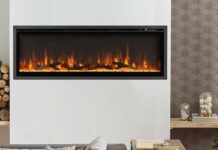 I have always been a big proponent of augmenting your home entertainment system with the full immersive sound of a surround sound system. This multi-speaker system truly surrounds the room with sound and typically has the technology to make the sound feel as if it is crossing the room, like a helicopter flying by. However, I also recognize there are many reasons why a surround sound system may not be a practical solution. Your space is too small or you are renting and can’t install all the necessary wires. Whatever your reason is, a soundbar or soundbase can be an excellent alternative.
I have always been a big proponent of augmenting your home entertainment system with the full immersive sound of a surround sound system. This multi-speaker system truly surrounds the room with sound and typically has the technology to make the sound feel as if it is crossing the room, like a helicopter flying by. However, I also recognize there are many reasons why a surround sound system may not be a practical solution. Your space is too small or you are renting and can’t install all the necessary wires. Whatever your reason is, a soundbar or soundbase can be an excellent alternative.
It used to be that soundbars were the only practical option to a full surround system but recently soundbases have really come into their own. Both are excellent ways of improving the sound quality of your entertainment system. I am going to explain how they are different, what the tradeoffs are, and what situations might favour one over the other, hopefully making it easier to choose the best option for your situation.
Fundamental Design Differences
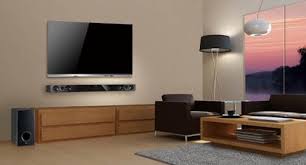 Soundbars and soundbases are aptly named because they describe what they look like. Soundbars are generally long and skinny speakers that look like a long bar, while the soundbase is very flat like a pancake but rectangular. The reason for the different profiles is that the soundbar is intended to either be wall mounted under a wall mounted TV or to sit under the TV in front of the TV stand. A soundbase is designed to sit directly under the TV stand supporting the full weight of the TV. In fact, they are usually rated by how heavy a TV they can support. You can also use a soundbase with a wall mounted TV and have it sit on the shelf on its own, but this is less typical.
Soundbars and soundbases are aptly named because they describe what they look like. Soundbars are generally long and skinny speakers that look like a long bar, while the soundbase is very flat like a pancake but rectangular. The reason for the different profiles is that the soundbar is intended to either be wall mounted under a wall mounted TV or to sit under the TV in front of the TV stand. A soundbase is designed to sit directly under the TV stand supporting the full weight of the TV. In fact, they are usually rated by how heavy a TV they can support. You can also use a soundbase with a wall mounted TV and have it sit on the shelf on its own, but this is less typical.
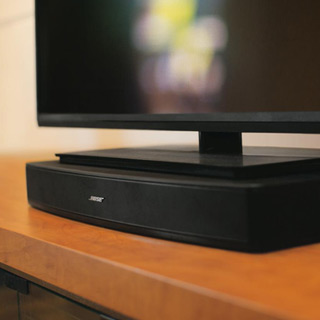 Soundbars and soundbases both have multiple speakers and most have at least three. Soundbars most often come with separate subwoofers because the bar itself has small speakers that aren’t capable of producing deep base. Many have a wireless subwoofer, which creates the simplest and most flexible setup. If it doesn’t come with a separate subwoofer, I would at least make sure it has a connection so you can easily add one should you decide you need more bass.
Soundbars and soundbases both have multiple speakers and most have at least three. Soundbars most often come with separate subwoofers because the bar itself has small speakers that aren’t capable of producing deep base. Many have a wireless subwoofer, which creates the simplest and most flexible setup. If it doesn’t come with a separate subwoofer, I would at least make sure it has a connection so you can easily add one should you decide you need more bass.
A soundbase usually creates its own bass by having separate drivers underneath to create that extra bass sound. It often uses the table or shelf it sits on to resonate a deeper bass sound. Therefore soundbases don’t come with an additional subwoofer.
Soundbar benefits
 If your TV is wall mounted, and I would highly recommend wall mounting any large screen TV (see my earlier post), then a sound bar can nicely accompany your TV since it can also be wall mounted. I would recommend getting a sound bar that is identical or very close to the width of your TV and place it directly beneath. Soundbars are generally engineered and tuned for wall mounting, so it will sound slightly better than if you simply placed the soundbar on the TV stand or shelf.
If your TV is wall mounted, and I would highly recommend wall mounting any large screen TV (see my earlier post), then a sound bar can nicely accompany your TV since it can also be wall mounted. I would recommend getting a sound bar that is identical or very close to the width of your TV and place it directly beneath. Soundbars are generally engineered and tuned for wall mounting, so it will sound slightly better than if you simply placed the soundbar on the TV stand or shelf.
Soundbars are more versatile because they can be wall mounted or placed on the stand in front of the TV. If you are placing it on the stand make sure that the TV’s base isn’t going to get in the way of the soundbar. Also, if you happen to have a bigger soundbar you will need to make sure that it doesn’t block the infra-red sensor on the TV which is generally located at the bottom. Otherwise your remote control might not work properly with the TV.
Because soundbars are generally much wider than soundbases, they will produce a wider field of sound, which is a bit better for playing stereo music. Depending on the bar, they will also tend to sound better in virtual surround mode, although it will never be as good as a proper surround system. Because most bars have a separate subwoofer, they generally do a better job on producing that deeper bass sound.
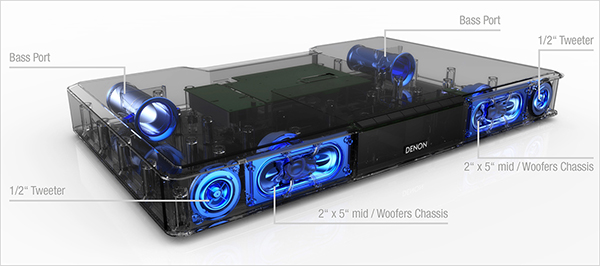 Soundbase benefits
Soundbase benefits
A soundbase is a very good option if you are not wall mounting your TV and space is an issue for you. The soundbase literally sits directly under the TV so it raises up the TV a couple of inches but actually takes up very little space. Also, because the soundbase doesn’t have a separate subwoofer it will take up less space.
By virtue of their design, soundbases have a lot more room in their cabinets. This generally means that they will have bigger drivers, the ability to include bass drivers, and better built-in amplification. And although soundbars have a wider field of sound, many soundbases have speakers facing front as well as speakers pushing sound out the sides for more sound dispersion. It is hard to say which is better in terms of delivering a more immersive sound experience and really varies from model to model.
Other Features to Consider
 Some convenient features that come with both soundbars and soundbases include things like Bluetooth connectivity so you can wirelessly play music from your mobile devices. Some have NFC (Near Field Communication) that make it even easier to pair devices. Another consideration is additional inputs that allow you to connect more devices, or optical inputs for your TV. Another nice feature to look for is multiple sound modes to enable ideal sound for gaming, movies, or voice programs like the news. Some of the better bars will also have a surround mode for even better sound effects.
Some convenient features that come with both soundbars and soundbases include things like Bluetooth connectivity so you can wirelessly play music from your mobile devices. Some have NFC (Near Field Communication) that make it even easier to pair devices. Another consideration is additional inputs that allow you to connect more devices, or optical inputs for your TV. Another nice feature to look for is multiple sound modes to enable ideal sound for gaming, movies, or voice programs like the news. Some of the better bars will also have a surround mode for even better sound effects.
Better sound generally comes when there are more speakers in the unit, although I have heard some three-speaker units that sound pretty good. If you do want better sound, and who doesn’t, make sure that the soundbar or soundbase has separate drivers for all three channels—treble, middle, and bass.
Another feature that is really nice to have is a streaming mode so it will play content directly from the Internet using a free app. Your Smartphone or tablet then becomes the remote for the unit, but many units also come with their own remote. Better yet is the capability to work with your universal remote.
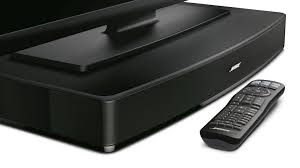 Choosing a system
Choosing a system
When comparing soundbars to soundbases it is important to compare similarly priced products, and think of some of the tradeoffs that I have mentioned above. An expensive soundbar will be better than a cheap soundbase and vice versa, so to be fair figure out your budget and compare similarly priced items. The most important test is your own ear, as sound is very personal. Some of us like a lot more bass and others like their sound to be more crisp and clear. So listen before you buy to make sure it suits your taste.
For some ideas on some great soundbars to choose from, look at this post on the top ones rated by consumers. Also if you want to get some more detail on soundbases, check out this post on the Vizio Soundbase. A couple of other excellent soundbases include the Bose Solo 15 TV Sound System and the JBL Cinema Base.
As TVs keep getting bigger they also continue to get thinner and more attractive, but usually at the cost of being able to produce decent sound. Thin squished speakers simply don’t cut it so investing in a soundbar or soundbase is a great way to improve the sound experience of your home theatre system. Think of the differences between them to pick the right one for you and by all means make sure you like the sound characteristics. There are a lot of great soundbars and soundbases to choose from in to fit anyone’s budget.


